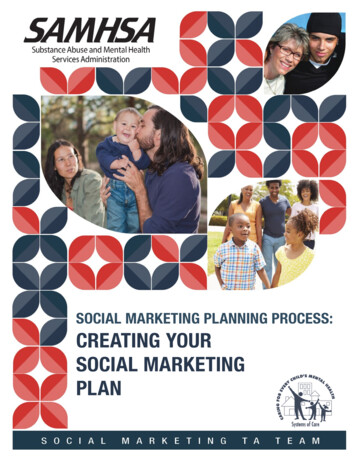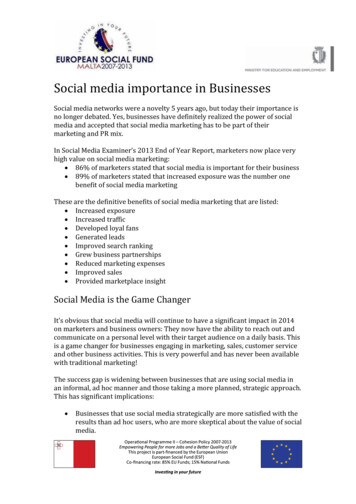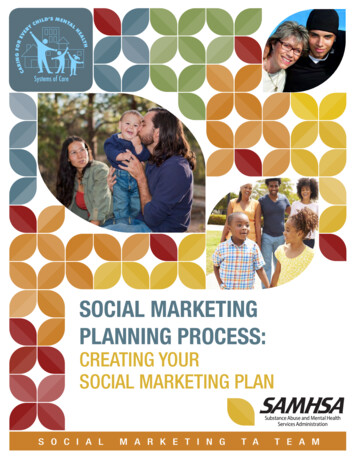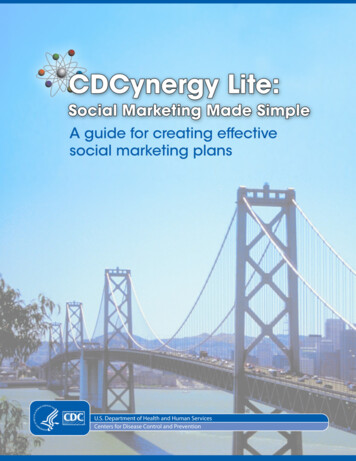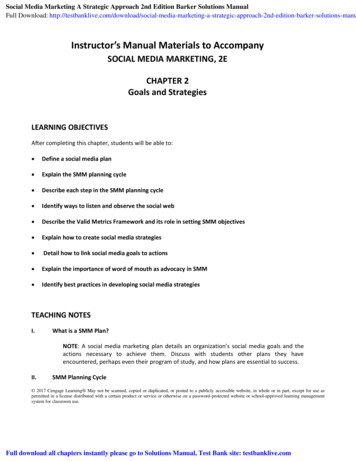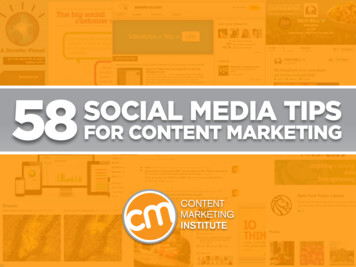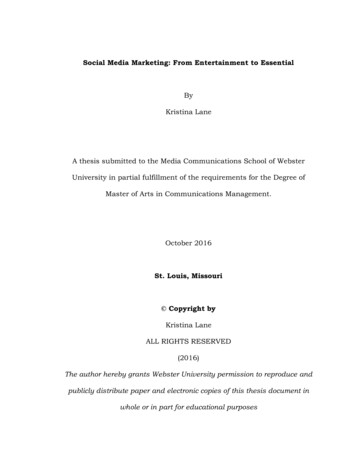
Transcription
Social Media Marketing: From Entertainment to EssentialByKristina LaneA thesis submitted to the Media Communications School of WebsterUniversity in partial fulfillment of the requirements for the Degree ofMaster of Arts in Communications Management.October 2016St. Louis, Missouri Copyright byKristina LaneALL RIGHTS RESERVED(2016)The author hereby grants Webster University permission to reproduce andpublicly distribute paper and electronic copies of this thesis document inwhole or in part for educational purposes
Lane 1ABSTRACTSocial Media Marketing: From Entertainment to EssentialByKristina LaneSocial media technologies have transformed the way the worldcommunicates. With over 3 billion people worldwide with access to theinternet, and 2 billion on social media, businesses are under pressurefrom the digital revolution to change the way they market andcommunicate their brands. What was originally created as anentertainment tool has revolutionized the communications andmarketing field. This paper examines the impact and role social mediahas on businesses.When utilized correctly, social media marketing can increase brandawareness, promote customer engagement and loyalty, inspire consumercommunication about the brand online and offline, drive traffic to thecompany’s website, as well as generate leads and increase sales.Supported by secondary research findings and utilization facts andfigures, the author aims to confirm the importance of social mediautilization by businesses, ultimately corroborating the idea that there arecompetitive disadvantages for businesses that do not utilize theseoutlets.
Lane 2Table of ContentsAcknowledgements . Error! Bookmark not defined.Abstract. 1List of Illustrations . 4Introduction . 5Situation Analysis . 5Premise . 6Limitations . 6Literature Review . 8Methodology . 10Chapter 1: The Growth of Digital Marketing . 12Chapter Two: Social Media . 15Definition. 15Brief History . 15Interactivity of Social Media . 17User-Generated Content . 19UGC and Millenials . 21Chapter 3: Top Performing Social Media for Business: Facebook,LinkedIn, Twitter & Instagram . 23
Lane 3Facebook . 25LinkedIn . 29Twitter . 34Instagram . 38Implementation Tips and Reminders . 42Chapter 4: Uses and Gratifications of Social Media. 43Uses and Gratifications Theory Explained . 43UGT and Social Media. 45UGT Application . 48Chapter 5: Social Media Marketing and its Benefits . 49Conclusion and Recommendations . 60Applicable Coursework . 61Works Cited . 67
Lane 4List of IllustrationsFigure 1Page 15Digital Marketing UmbrellaFigure 2Page 18History of Social MediaFigure 3Page 19Characteristics of Online MediaFigure 4Page 22Media TrustworthinessFigure 5Page 23Millennials Media PrioritiesFigure 6Page 24Conversation PrismFigure 7Page 252016 Companies Using SMMFigure 8Page 26Best ROI Social PlatformsFigure 9Page 27Facebook User MapFigure 10Page 31LinkedIn User MapFigure 11Page 35Active Twitter UsersFigure 12Page 39Monthly Instagram UsersFigure 13Page 45Needs Gratified by MediaFigure 14Page 48Social Media as News OutletFigure 15Page 50Benefits of SMM
Lane 5IntroductionSituation AnalysisAs of 2016, there are an estimated 1.96 billion social media usersworldwide. This number is projected to grow to 2.5 billion by 2018. In theUnited States alone, 185 million people use social media, connoting that78 percent of Americans are on some form of social media (U.S.population with a social media profile 2016 Statistic). These numbersare a powerful indicator of the influence that social media have in today’ssociety. Initially used for entertainment, social media has evolved into apowerful marketing tool. In 2014, eMarketer surveyed organizations with100 or more employees across the United States and found that 88percent, or nine in 10 companies, are using social media for marketingpurposes (Bennett 2014).When utilized effectively, social media creates brand awareness,offers an easily accessible platform for updates, acts as an effectivemeans for crisis communications, and enhances the relationship withcurrent and potential customers. With hundreds of platforms to choosefrom, it can be difficult for marketers to understand where their presenceis best utilized. What began as simple, free communication tools evolvedinto marketing moguls with a plethora of sponsored content options.Based on these technology advancements, Forrester Research, a wellrespected American independent technology and market research
Lane 6company, projected that social media spending for businesses willincrease from 7.52 billion dollars in 2014 to 17.34 in just five years.Deemed the most promising communication tool for reaching andinteracting with stakeholders, what impact does social media utilizationhave on the one of 10 companies that is not represented on theseplatforms (Vernuccio 2014)? As a new and transformative tool, the exactimpact in terms of return of investment, or ROI, and overall impact ofsocial media on businesses is still vague and requires more research.This paper explores the power of social media in today’s business worldwhile emphasizing the importance of representation for businesses.PremiseIn today’s society, businesses that do not utilize social mediaplatforms face competitive disadvantages compared to organizations thateffectively implement them as a marketing tactic.LimitationsAs a University of North Florida graduate with a Bachelor’s incommunications and a career as a marketing communications specialist,conducting research for this paper came as second nature for the author.One of the main responsibilities of a marketing communicationsprofessional is managing and creating content for an organization’s socialmedia pages. Considering this information, one could assume there wasa personal bias in validating social media’s importance and impact on
Lane 7businesses. This personal bias could have impacted the sources utilizedthroughout the paper, as the author may have excluded sourcesdoubting social media’s importance in the workplace.Another limitation was the timeframe of nine weeks to completethis 75 to 100-page project. Already a short timeframe for such an indepth project, the author contended with working full time. This left theauthor with weekends to complete the project, resulting in the utilizationof paid time off in order to fulfill the necessary requirements.This time restriction also eliminated the ability to conduct primaryresearch, which was a previous requirement for other Webster graduates.Had time permitted, the author could have conducted surveys or focusgroups with co-workers to learn about their social media usage, how theyinteract with other businesses, and if social media has ever impactedtheir purchasing decisions. The author also could have conductedsimilar studies with her employer’s client base while comparing andcontrasting the results and insights obtained through the employer’ssocial media accounts.In addition to the mentioned limitations, social media has evolvedrapidly, resulting in limited research surrounding the exact impact andvalue of social media on businesses. Marketers are still trying todetermine best practices and how to leverage insights provided byanalytics. As social media utilization continues to multiply and
Lane 8marketers gain a better understanding of the tool, more studies andresearch will become available regarding social media and its exactimpact on businesses.Literature ReviewWith almost half of the population active on the internet, it is nosurprise social media has become an essential marketing tool forbusinesses. As such, marketers and researchers alike are desperate tounderstand and implement these tools. The secondary research utilizedin this paper reinforces the idea that businesses not utilizing socialmedia as a marketing tactic face competitive disadvantages compared toorganizations that do.To establish the grounds of this paper, the author relied heavily onPride and Ferrell’s 2014 edition of Marketing. This text supplied thefoundation of the paper by defining and illustrating digital marketing anddigital media. Social media is a digital marketing strategy that resultedfrom the dramatic impact of the internet and information technology onthe marketing environment. The information provided in this text set thetone for this paper and revealed the sections required to prove thepremise.Some of the most pertinent information utilized for this paper camedirectly from the four identified social mediums’ websites. With 5.2billion recorded in advertising costs, it is no surprise that the Facebook
Lane 9and Instagram for Business page contains endless statistics and casestudies demonstrating the power of Facebook and Instagram ads(Seetharaman, 2016). Twitter and LinkedIn have made similarinvestments in substantiating the power of sponsored content throughtheir mediums. Each corresponding medium provided in depthinformation on the functions of the business applications as well asproven data associated with their implementation. This information madethe social mediums “about” sections vital sources that were easilyaccessible to the author.The Pew Research Center, eMarketer, and Statista also providedintegral insight and statistics that were imperative to substantiating thepremise. The Pew Research Center provides data from social scienceresearch on public issues and attitudes and trends that shape Americaas well as the rest of the world. Statista provides quantitative data andstatistics for businesses and academics, while eMarketer focuses onbenchmarks and insights from combined methodologies from the world’sbest researchers.For the purposes of this paper, the author utilized a plethora ofinformation from eMarketer and Statista because of their credentials andexpertise. Statista is strategic partners with the Interactive AdvertisingBureau, the American Association of Advertising Agencies, as well asmedia partners with sites such as Wall Street Journal and Forbes, many
Lane 10of which are referenced to throughout this paper as well. eMarketer isone of the most widely cited research providers in the media, quoted byvirtually every major news outlet in the world, making both sourcescritical to this paper.Several academic journal articles supplied important informationregarding the uses and gratifications theory as well as insight into howsocial media channels and strategies relate to consumer engagement andbranding. As a powerful tool with vague statistical benefits, the authorbenefited from extremely recent research studies.Although a number of sources were only referenced to oncethroughout this project, each article played an important role in thequality of this thesis and should still be considered an important elementof the body of research on the topic.MethodologyThe idea for this paper began after receiving advice from a WebsterUniversity advisor to pick a topic prior to the beginning of the course dueto the time limitations. With plenty of personal, educational, andprofessional experience with social media, the author narrowed the topicdown to the validity of social media use for businesses. After refining thetopic, the premise statement was created and vigorous secondaryresearch began.
Lane 11As referenced in limitations, the author analyzed and focused onsecondary research. Initially the author utilized the academic journaldatabase, Communication & Mass Media Complete, which includescontent from two established indexes as well as other major journals inthis field. Academic Search Complete, or EBSCO, was also used, as itoffers a comprehensive multidisciplinary full-text database. In addition,the author also applied several articles from business websites thatdemonstrated the different implementations and success storiesregarding social media. In addition to the communications aspect of thisresearch, the author relied heavily on numerous statistical reports thataided and supported the premise statement.The result of this approach is an academic paper that presents anaccurate overview of social media and what it means for businesses.
Lane 12Chapter 1: The Growth of Digital MarketingSince the launch of the World Wide Web in 1990, the internet andtechnology have drastically changed the marketing environment as wellas the strategies necessary to succeed. With these changes came thebirth of digital media. Digital mediums have created opportunities forcompanies to target specific markets more effectively, develop newmarketing strategies, and gather more information that enablesmarketers to better analyze and address consumer needs (Pride &Ferrell, 2014).One of the most defining characteristics of information technologyin the 21st century is its ability to change at a rapid pace. With digitalmedia consistently creating new opportunities within the marketingenvironment, it is imperative for businesses to implement and changetheir behaviors to fit with emerging technologies and trends. Whenexecuted correctly, businesses position themselves to better connect withconsumers, obtain valuable insight about their target markets, andconvert this information into successful marketing strategies (Pride &Ferrell, 2014).Digital MarketingDigital media are considered electronic media that function usingdigital codes. In other words, digital media refers to any and all mediaavailable through computers, cell phones, smartphones, and any other
Lane 13digital device. These digital mediums are used in digital marketing todevelop communication and exchanges with customers through theinternet, mobile, and all interactive channels (Pride & Ferrell, 2014).Due to the phenomenal growth of the internet, marketers have anunprecedented amount of opportunities to forge interactive relationshipswith consumers. Through advanced communication technologies,businesses are able to reach markets through precision targeting thatwere previously inaccessible. Because of the internet’s ability to enhancethe exchange of information between the marketer and the customer,businesses are learning to make the internet a vital part of theirmarketing strategies. In fact, internet marketing is now incorporated inall digital media, including television advertisements and otherinteractive media that do not utilize the internet (Pride & Ferrell, 2014).As such, digital marketing is really an umbrella term used toencompass all aspects of anorganization’s digitalmarketing efforts (see figure1). These tactics includeblogging, e-mail marketing,web marketing, digitalmarketing, search engineFigure 1
Lane 14optimization (SEO), mobile marketing, social media marketing andbeyond.With over 3 billion internet users around the world, the internethas changed the way the world communicates (Pew Research Center). Tosucceed in the digital age, marketers are forced to focus on digitalmarketing through every channel available. Through these channels,marketers are able to form relationships with a variety of stakeholders,current and future customers, employees, and suppliers through e-mail,smartphones, social networking, wikis, media sharing sites, podcasts,video blogs, and other technologies (Pride & Ferrell, 2014).
Lane 15Chapter Two: Social MediaSocial networking sites, often referred to as social media, arechanging the dynamics of marketing and business communication.Because of the accessibility, popularity, potential reach, and low costs,social mediums present tremendous communication and marketingopportunities for any industry, while also posing threats for those that donot engage in digital and online marketing (Pride & Ferrell, 2014).DefinitionIn August of 2011, Merriam-Webster Inc. added the word “socialmedia” to the Merriam-Webster Collegiate Dictionary. The officialMerriam-Webster definition of social media are:forms of electronic communication (as Web sites for socialnetworking and microblogging) through which users createonline communities to share information, ideas, personalmessages, and other content (as videos).Merriam-Webster’s editor at the time stated they had been trackingwords like “social media” and “tweet” for years, and finally felt theirmeanings had stabilized enough to be included in the dictionary (2011).Brief HistoryDespite Merriam-Webster’s assessment that the first known use ofthe word social media occurred in 2004, the first recognizable social
Lane 16media site, Six Degrees, was created in 1997. While social media did nottechnically exist before 1997, the current social media phenomenon isthe result of many centuries of communication development (Hendricks,2013).The earliest recognized methods of long distance communicationinvolved hand written letters. The beginning of the postal service datesback to 550 B.C. and is still a widespread, streamlined form ofcommunication today. Fast forward to 1792, and the telegraph wasinvented. This enabled messages to be delivered over long distances in ashorter amount of time than a horse and rider, and at the time was arevolutionary way to convey news and information. Two more importantdiscoveries occurred in the last decade of the 1800s, the telephone in1890 and the radio shortly after in 1891 (Hendricks, 2013).The way the world communicated changed rapidly in the 20thcentury with the invention of technology and computers, leading to theeventual birth of the internet. Soon after, the first blogging sites arrived,sparking a social media sensation. Sites such as Myspace and LinkedIngained prominence in the early 2000s, and by 2006, Facebook andTwitter had officially launched the social media phenomenon (Hendricks,2013). Some of the most memorable forms of communication are
Lane 17illustrated infigure 2, bringingus to 2016 withover 3 billioninternet usersand 2 billionactive users onsocial media(Copp).Interactivity ofSocial MediaSocialmediums offer anew dimensionFigure 2to marketingthat require serious consideration when forming strategic marketingstrategies. One of the largest mistakes a marketer can make with digitalmarketing is treating it as a traditional media channel. Somecharacteristics that distinguish online media from traditional media are
Lane 18addressability, interactivity, accessibility, connectivity, and control(Pride, Ferrell 2014). These terms are defined in figure three.Figure 3Out of these terms, interactivity is the most distinguishingcharacteristic of social media. Social media enables businesses tointeract with its stakeholders, while traditional marketing usuallyinvolves one-way forms of communication (Pride & Ferrell, 2014).Unlike traditional marketing, social media facilitates an open lineof communication with the customer. The interactivity of social mediaalleviates the sometimes lengthy process of attempting to reach anorganization. Depending on the form of feedback provided throughtraditional marketing, consumers may be placed on hold or receive an
Lane 19automated response, resulting in customer dissatisfaction (Pride &Ferrell, 2014).By utilizing appropriate social mediums, companies can facilitateinteractivity and enable a conversation with the customer. Anotherbenefit of social media is the ability for consumers to view marketingmessages at their own pace, taking away from the more intrusivemarketing tactics. Social networks allow customers to interact withbusinesses when they choose, promoting a greater interaction andrelationship between the business and consumer (Pride & Ferrell).Interactivity promotes and nurtures premium relationships withexisting customers while shaping customer expectations andperceptions. The internet has provided a myriad of relationshippossibilities between business and consumer, as well as consumer toconsumer. This relationship between customers opens up an entiredifferent form of user-generated marketing (Pride & Ferrell, 2014).User-Generated ContentSocial mediums are more consumer-driven than any other form oftraditional media, creating the opportunity for marketers to utilize usergenerated content. According to dictionary.com, user-generated content,or UGC, refers to any data or media that is contributed by individualusers of a website. This refers to any material created and uploaded tothe internet by non-media professionals. While the concept of user-
Lane 20generated content has been around in one form or another since thebeginning of the internet, the growing availability of the internet hasmade UGC one of the fastest growing and most dominant forms of globalmedia ("IAB Platform Status Report: User Generated Content, SocialMedia, and Advertising - An Overview", 2008). As previously stated, over3 billion people in the world have access to the internet, meaning over 3billion people have access to create and utilize user-generated content.In today’s booming digital marketing environment, consumersdecide where, when, and how they want to engage with brands.Consumers also tend to share their experiences regarding theirexperiences, products they use, and the brands they prefer. Thesecustomer testimonials are highly influential on other buyers as consumeropinions are trusted more than typical brand messaging ("UserGenerated Content's Impact on Brand Building", 2014).Understanding which forums online users are likely to expresstheir thoughts and opinions on enable the business to utilize thesemediums to interact with consumers, address problems, and promotetheir companies (Pride & Ferrell, 2014).
Lane 21UGC and MillenialsWhile people have been sharing stories about brands for decades,technology, especially social media, has made it easier to produce andshare the content that once depended on word-of-mouth, or WOM. Withmillennials leadingthe economy innumbers andpurchasing power,marketers cantarget thisgeneration throughthe content they areknown to trust theFigure 4most usergenerated content(see figure 4)(Comcowich).Millennials represent nearly 27 percent of America’s populationand have an estimated 1.3 trillion in consumer spending, making itvital for organizations to understand where users are likely to expresstheir thoughts and opinions (Comcowich). Millennials spend nearly 30percent of their total media time with content that is created and sharedby their peers, rivaling the amount of time they spend with any other
Lane 22traditional media formats combined (Statista). Based on the fact thatover 90 percentof millennialshave access toa smart phoneand theresearch infigure 5,businesses canassumemillennialsFigure 5receive the majority of their UGC through social media. With consumertrust in traditional media dwindling and more time spent with UGC,businesses are forced to shift their focus to opportunities that drivemedia impact.
Lane 23Chapter 3: Top Performing Social Media for Business:Facebook, LinkedIn, Twitter & InstagramSometimes referred to as social networking, digital media, Web 2.0,or NextGen PR, social media come in many different forms with differentpurposes (see figure 6). Social mediums range from blogs, to microblogging sites like Twitter, wikis, social networking such as Facebook,podcasting,video and photosharing siteslike Instagramand YouTube, aswell asdiscussionforums. Socialmedia isconsideredFigure 6distinct from traditionalmedia because it relies onuser-generated contentopposed to institutional content. The cost of creating and disseminatingcontent on social media is either free or relatively inexpensive. Thisincentive provides businesses with a low-cost technique to develop
Lane 24relationships with members of various strategic publics while positivelyimpacting organizational transparency on a world stage (Dainton, Correa,Kohr, Taormina 2013).Just a few years ago,social media was considered amillennial phase that businessescould not benefit from. In 2016,almost nine in 10 companies inthe United States are usingsocial media for marketingpurposes (see figure 7). In fact,social media marketing, or SMM,Figure 7is one of the latest additions tothe digital marketing “umbrella”.Marketing experts definesocial media marketing as a form of internet marketing that utilizessocial networking as a marketing tool. The aim of social media marketingis to produce content that users will share with their social network,ultimately increasing brand exposure and broadening the businesses’customer reach (Rouse, 2011).According to a recent study provided by Statista, internet usersworldwide spend an average of 118 minutes per day on social media.
Lane 25That is 118 minutes a day that businesses are missing an opportunity toreach current and potential customers!In addition to changing the way people around the worldcommunicate, social media platforms have become vital marketing tools,offering an array of benefits for businesses (Statista). Just as quickly asit became clear socialmedia is a necessarytool for businesses tothrive, it becameequally as clear thatbusinesses strugglewith determining whichsocial media outlets toutilize and how to useFigure 8them. With over 50 different social mediums to choose from, businessesneed to understand where to invest their time and attention. For thepurposes of this thesis, the author focuses on four of the most popularsocial mediums worldwide, which are illustrated in figure eight.FacebookFacebook was launched on February 4, 2004. Created by MarkZuckerberg, Facebook’s mission is “to give people the power to share andmake the world more open and connected.” Recognized as the biggest
Lane 26social media network on the Internet, Facebook has managed toaccumulate 1.71 billion monthly active users in only 12 years. Nearly1.13 billion people access Facebook every day, whether through desktopor through their mobile device (Company Info Facebook Newsroom).Originally headquartered in California, Facebook has 14,495employees with offices all over the United States as well asinternationally. Inorder to support aglobal audience,Facebooksupports 70-pluslanguages and theability to translateFigure 9text while on Facebook. Approximately 84.5% of Facebook’s daily activeusers are outside the US and Canada (see figure 9).Facebook PagesIntroduced in November of 2007, Facebook Pages are publicprofiles that allow businesses, artists, public figures, brands,organizations, and non-profits to have a presence on Facebook. When auser decides to like a Page, they begin seeing updates in their news feed.When a user likes or comments on a Page’s post, this activity may be
Lane 27shared with their friends, increasing the Page’s exposure and reach(Facebook).Marketing on Facebook begins with creating a Page. Pages givebusinesses a voice and presence on Facebook, and are designed to helppromote and connect the business. With people all over the world visitingFacebook to connect with friends, when utilized correctly, Facebook candrive online sales, increase local sales, and raise brand awareness. Pagesare also available on mobile devices, making them easily accessible to thebillion people that visit Facebook Pages each month from their smartphone (Facebook).Facebook Pages are completely customizable, and helpdemonstrate what businesses are really about. Adding businessinformation like company website, hours and contact information,descriptions, services, etc. allow customers to discover the business, aswell as make it more accessible from search engines like Google.Customers also have the ability to rate the business and write reviews,which tend to be the most trusted form of marketing.In addition to showcasing information about the business,Facebook Pages allow businesses to create Page Posts. Page Posts keepcustomers and potential customers informed about the business.Facebook Page Posts can be as simple as plain text, to eye catchingphotos and videos, to event invitations, to milestones, and even to added
Lane 28links to drive engagement to businesses’ websit
Social Media Marketing: From Entertainment to Essential By . Statista is strategic partners with the Interactive Advertising Bureau, the American Association of Advertising Agencies, as well as . The result of this approach is an academic paper that presents an accurate overview of


